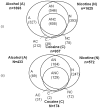The nuclear transcription factor PKNOX2 is a candidate gene for substance dependence in European-origin women
- PMID: 21298047
- PMCID: PMC3029286
- DOI: 10.1371/journal.pone.0016002
The nuclear transcription factor PKNOX2 is a candidate gene for substance dependence in European-origin women
Abstract
Substance dependence or addiction is a complex environmental and genetic disorder that results in serious health and socio-economic consequences. Multiple substance dependence categories together, rather than any one individual addiction outcome, may explain the genetic variability of such disorder. In our study, we defined a composite substance dependence phenotype derived from six individual diagnoses: addiction to nicotine, alcohol, marijuana, cocaine, opiates or other drugs as a whole. Using data from several genomewide case-control studies, we identified a strong (Odds ratio = 1.77) and significant (p-value = 7E-8) association signal with a novel gene, PBX/knotted 1 homeobox 2 (PKNOX2), on chromosome 11 with the composite phenotype in European-origin women. The association signal is not as significant when individual outcomes for addiction are considered, or in males or African-origin population. Our findings underscore the importance of considering multiple addiction types and the importance of considering population and gender stratification when analyzing data with heterogeneous population.
Conflict of interest statement
Figures
Similar articles
-
PKNOX2 gene is significantly associated with substance dependence in European-origin women.Proc Natl Acad Sci U S A. 2009 Sep 10. doi: 10.1073/pnas.0908521106. Online ahead of print. Proc Natl Acad Sci U S A. 2009. Retraction in: Proc Natl Acad Sci U S A. 2009 Oct 6;106(40):17241. doi: 10.1073/pnas.0910252106. PMID: 19721000 Retracted.
-
Association of the OPRM1 Variant rs1799971 (A118G) with Non-Specific Liability to Substance Dependence in a Collaborative de novo Meta-Analysis of European-Ancestry Cohorts.Behav Genet. 2016 Mar;46(2):151-69. doi: 10.1007/s10519-015-9737-3. Epub 2015 Sep 21. Behav Genet. 2016. PMID: 26392368 Free PMC article.
-
Substance dependence low-density whole genome association study in two distinct American populations.Hum Genet. 2008 Jun;123(5):495-506. doi: 10.1007/s00439-008-0501-0. Epub 2008 Apr 26. Hum Genet. 2008. PMID: 18438686 Free PMC article.
-
Common and distinguishing genetic factors for substance use behavior and disorder: an integrated analysis of genomic and transcriptomic studies from both human and animal studies.Addiction. 2022 Sep;117(9):2515-2529. doi: 10.1111/add.15908. Epub 2022 May 10. Addiction. 2022. PMID: 35491750
-
"Higher order" addiction molecular genetics: convergent data from genome-wide association in humans and mice.Biochem Pharmacol. 2008 Jan 1;75(1):98-111. doi: 10.1016/j.bcp.2007.06.042. Epub 2007 Jul 25. Biochem Pharmacol. 2008. PMID: 17764662 Free PMC article. Review.
Cited by
-
Arc Regulates Transcription of Genes for Plasticity, Excitability and Alzheimer's Disease.Biomedicines. 2022 Aug 11;10(8):1946. doi: 10.3390/biomedicines10081946. Biomedicines. 2022. PMID: 36009494 Free PMC article.
-
SNP by SNP by environment interaction network of alcoholism.BMC Syst Biol. 2017 Mar 14;11(Suppl 3):19. doi: 10.1186/s12918-017-0403-7. BMC Syst Biol. 2017. PMID: 28361705 Free PMC article.
-
NCK2 is significantly associated with opiates addiction in African-origin men.ScientificWorldJournal. 2013;2013:748979. doi: 10.1155/2013/748979. Epub 2013 Feb 28. ScientificWorldJournal. 2013. PMID: 23533358 Free PMC article.
-
Modeling Hybrid Traits for Comorbidity and Genetic Studies of Alcohol and Nicotine Co-Dependence.Ann Appl Stat. 2018 Dec;12(4):2359-2378. doi: 10.1214/18-AOAS1156. Epub 2018 Nov 13. Ann Appl Stat. 2018. PMID: 30666272 Free PMC article.
-
Genetic association test for multiple traits at gene level.Genet Epidemiol. 2013 Jan;37(1):122-9. doi: 10.1002/gepi.21688. Epub 2012 Oct 2. Genet Epidemiol. 2013. PMID: 23032486 Free PMC article.
References
-
- Centers for Disease Control and Prevention (CDC) State-specific smoking-attributable mortality and years of potential life lost–United States, 2000-2004. MMWR Morb Mortal Wkly Rep. 2009;58:29–33. - PubMed
-
- Makhija NJ, Sher L. Preventing suicide in adolescents with alcohol use disorders. Int J Adolesc Med Health. 2007;19:53–59. - PubMed
-
- Uhl GR, Elmer GI, Lanuda MC, Pickens RW. Genetic influences in drug abuse. In: Bloom FE, Kupfer DJ, editors. Psychopharmacology: The Fourth Generation of Progress. New York: Lippincott Williams & Wilkins; 1995. pp. 1793–1806.
-
- True WR, Heath AC, Scherrer JF, Xian H, Lin N, et al. Interrelationship of genetic and environmental influences on conduct disorder and alcohol and marijuana dependence symptoms. Am J Med Genet. 1999;88:391–397. - PubMed
-
- Merikangas KR, Stolar M, Stevens DE, Goulet J, Preisig MA, et al. Familial transmission of substance use disorders. Arch Gen Psychiatry. 1998;55:973–979. - PubMed
Publication types
MeSH terms
Substances
Grants and funding
- U01HG004438/HG/NHGRI NIH HHS/United States
- U01 HG004438/HG/NHGRI NIH HHS/United States
- R01 DA016750/DA/NIDA NIH HHS/United States
- P01 CA089392/CA/NCI NIH HHS/United States
- U01 HG004422/HG/NHGRI NIH HHS/United States
- R01 DA013423/DA/NIDA NIH HHS/United States
- K02 DA017713/DA/NIDA NIH HHS/United States
- U10 AA008401/AA/NIAAA NIH HHS/United States
- K02DA017713/DA/NIDA NIH HHS/United States
- T32 MH014235/MH/NIMH NIH HHS/United States
- U01 HG004446/HG/NHGRI NIH HHS/United States
- HHSN268200782096C/HG/NHGRI NIH HHS/United States
- R01DA016750/DA/NIDA NIH HHS/United States
LinkOut - more resources
Full Text Sources
Medical
Research Materials


